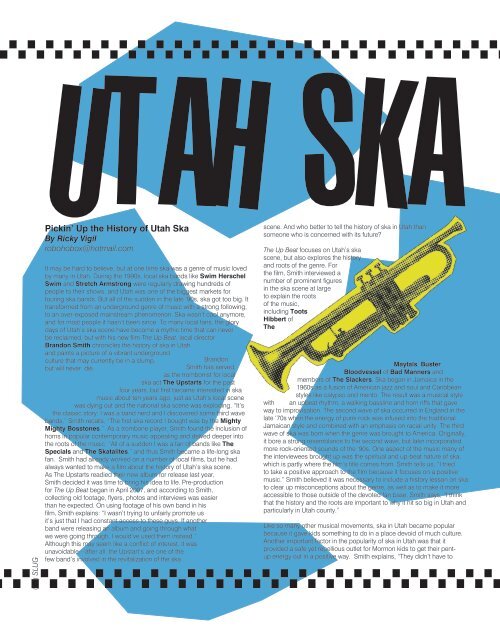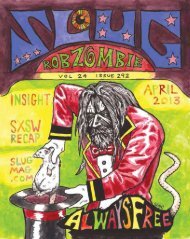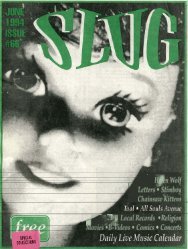Create successful ePaper yourself
Turn your PDF publications into a flip-book with our unique Google optimized e-Paper software.
(40) <strong>SLUG</strong><br />
Pickin’ Up the History of Utah Ska<br />
By Ricky Vigil<br />
robohobox@hotmail.com<br />
It may be hard to believe, but at one time ska w<strong>as</strong> a genre of music loved<br />
by many in Utah. During the 1990s, local ska bands like Swim Herschel<br />
Swim and Stretch Armstrong were regularly drawing hundreds of<br />
people to their shows, and Utah w<strong>as</strong> one of the biggest markets for<br />
touring ska bands. But all of the sudden in the late ‘90s, ska got too big. It<br />
transformed from an underground genre of music with a strong following,<br />
to an over-exposed mainstream phenomenon. Ska w<strong>as</strong>n’t cool anymore,<br />
and for most people it h<strong>as</strong>n’t been since. To many local fans, the glory<br />
days of Utah’s ska scene have become a mythic time that can never<br />
be reclaimed, but with his new film The Up Beat, local director<br />
Brandon Smith chronicles the history of ska in Utah<br />
and paints a picture of a vibrant underground<br />
culture that may currently be in a slump,<br />
Brandon<br />
but will never die.<br />
Smith h<strong>as</strong> served<br />
<strong>as</strong> the trombonist for local<br />
ska act The Upstarts for the p<strong>as</strong>t<br />
four years, but first became interested in ska<br />
music about ten years ago, just <strong>as</strong> Utah’s local scene<br />
w<strong>as</strong> dying out and the national ska scene w<strong>as</strong> exploding. “It’s<br />
the cl<strong>as</strong>sic story: I w<strong>as</strong> a band nerd and I discovered some third wave<br />
bands,” Smith recalls, “The first ska record I bought w<strong>as</strong> by the Mighty<br />
Mighty Bosstones.” As a trombone player, Smith found the inclusion of<br />
horns in popular contemporary music appealing and delved deeper into<br />
the roots of the music. “All of a sudden I w<strong>as</strong> a fan of bands like The<br />
Specials and The Skatalites,” and thus Smith became a life-long ska<br />
fan. Smith had already worked on a number of local films, but he had<br />
always wanted to make a film about the history of Utah’s ska scene.<br />
As The Upstarts readied their new album for rele<strong>as</strong>e l<strong>as</strong>t year,<br />
Smith decided it w<strong>as</strong> time to bring his idea to life. Pre-production<br />
for The Up Beat began in April 2007, and according to Smith,<br />
collecting old footage, flyers, photos and interviews w<strong>as</strong> e<strong>as</strong>ier<br />
than he expected. On using footage of his own band in his<br />
film, Smith explains: “I w<strong>as</strong>n’t trying to unfairly promote us<br />
it’s just that I had constant access to these guys. If another<br />
band were rele<strong>as</strong>ing an album and going through what<br />
we were going through, I would’ve used them instead.”<br />
Although this may seem like a conflict of interest, it w<strong>as</strong><br />
unavoidable––after all, the Upstart’s are one of the<br />
few band’s involved in the revitalization of the ska<br />
scene. And who better to tell the history of ska in Utah than<br />
someone who is concerned with its future?<br />
The Up Beat focuses on Utah’s ska<br />
scene, but also explores the history<br />
and roots of the genre. For<br />
the film, Smith interviewed a<br />
number of prominent figures<br />
in the ska scene at large<br />
to explain the roots<br />
of the music,<br />
including Toots<br />
Hibbert of<br />
The<br />
Maytals, Buster<br />
Bloodvessel of Bad Manners and<br />
members of The Slackers. Ska began in Jamaica in the<br />
1960s <strong>as</strong> a fusion of American jazz and soul and Caribbean<br />
styles like calypso and mento. The result w<strong>as</strong> a musical style<br />
with an upbeat rhythm, a walking b<strong>as</strong>sline and horn riffs that gave<br />
way to improvisation. The second wave of ska occurred in England in the<br />
late ‘70s when the energy of punk rock w<strong>as</strong> infused into the traditional<br />
Jamaican style and combined with an emph<strong>as</strong>is on racial unity. The third<br />
wave of ska w<strong>as</strong> born when the genre w<strong>as</strong> brought to America. Originally,<br />
it bore a strong resemblance to the second wave, but later incorporated<br />
more rock-oriented sounds of the ‘90s. One <strong>as</strong>pect of the music many of<br />
the interviewees brought up w<strong>as</strong> the spiritual and up-beat nature of ska,<br />
which is partly where the film’s title comes from. Smith tells us, “I tried<br />
to take a positive approach to the film because it focuses on a positive<br />
music.” Smith believed it w<strong>as</strong> necessary to include a history lesson on ska<br />
to clear up misconceptions about the genre, <strong>as</strong> well <strong>as</strong> to make it more<br />
accessible to those outside of the devoted fan b<strong>as</strong>e. Smith says, “I think<br />
that the history and the roots are important to why it hit so big in Utah and<br />
particularly in Utah county.”<br />
Like so many other musical movements, ska in Utah became popular<br />
because it gave kids something to do in a place devoid of much culture.<br />
Another important factor in the popularity of ska in Utah w<strong>as</strong> that it<br />
provided a safe yet rebellious outlet for Mormon kids to get their pentup<br />
energy out in a positive way. Smith explains, “They didn’t have to

















